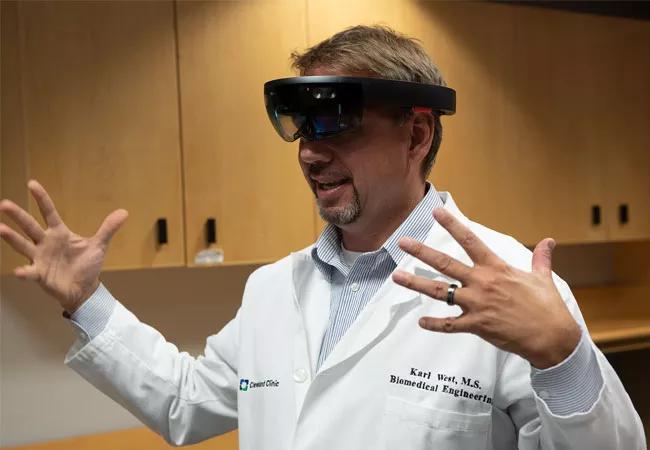Leveraging Microsoft HoloLens and 3D printing to improve surgical outcomes

Karl West, Director of Medical Device Solutions at Cleveland Clinic and a staff member in Lerner Research Institute (LRI), Department of Biomedical Engineering, discusses how biomedical engineering has the potential to transform surgical innovation and improve patient care.
Advertisement
Cleveland Clinic is a non-profit academic medical center. Advertising on our site helps support our mission. We do not endorse non-Cleveland Clinic products or services. Policy
Within LRI, the simple answer is my team and I apply science to clinical ideas, turning the thought into a potential invention to improve patient care. We add the engineering components taking the idea to reality. In the end, our mission is to improve patient care. In the biomedical engineering space, it’s more about improving visualization for minimally invasive surgical procedures. It can be hardware or software-related. This is where we are working with the Microsoft HoloLens and 3D printing to improve surgical outcomes.
The best way to explain the HoloLens is by comparing it to someone having an X-ray vision. It allows clinicians to see the anatomy as it naturally is providing greater confidence in the treatment of the patient as if doing an open surgical procedure but minimally invasively. We develop ancillary devices and software; think of it as the apps that make the HoloLens clinically usable.
Yes, there was a patient with a large lesion on her liver. The physician, using a CT data set which is the standard of care, explained her condition to her family, asked if there were any questions. The family had none. Then, they used the HoloLens and the family could visualize the lesion in 3D; they understood what they were looking at and had many questions.
Not research necessarily, but I was always drawn to innovating. I grew up working on small farms and you have to be innovative to keep things working. I kept a notebook with all my ideas. My passion to invent came from my father and grandfather.
Advertisement
I first learned to develop and design machines at a small company in Madison, Ohio. I then transitioned to Philips Medical Systems where I worked on CT scanners. That exposed me to the medical space. While working there, I visited LRI and fell hard for it. I realized I had a passion to be connected to the clinical space. The ability to work at an institute like Cleveland Clinic opened my eyes to what we can do as researchers to improve patient care. I can’t think of a better place to be.
If you are doing a particular job, or even watching someone else, and think there is a better way of doing it — that’s innovation. That’s how it all gets started; seeing a better way of doing a task.
Reducing radiation exposure to patients. That is a real passion of mine. We created a 3D, GPS-like tool for surgical navigation that greatly reduces radiation exposure. It’s now Centerline Biomedical, a Cleveland Clinic Innovations spin-off. We also were able to take that technology and expand it to percutaneous cancer treatment. I have a lot of interest there. MediView XR, a startup company, was just created. This also will allow surgeons to ablate a lesion using a Holographic Guidance technology.
If you feel part of a good team, or family, you want to do better. No one on the team is more important than another, everyone has a task and you respect that. Treat people equally, let them know their contributions matter, create a great environment in which to work. Everyone on my team has different specialties and that’s how we become successful.
Advertisement
I worked closely with the late Roy Greenberg, MD. He died at age 49 from cancer. He always said to “apply science to ideas.” That really stuck with me. Applying science to a colleague’s idea, creating something new is of great importance to our mission at LRI.
Advertisement
Advertisement

First full characterization of kidney microbiome unlocks potential to prevent kidney stones

Researchers identify potential path to retaining chemo sensitivity

Large-scale joint study links elevated TMAO blood levels and chronic kidney disease risk over time

Investigators are developing a deep learning model to predict health outcomes in ICUs.

Preclinical work promises large-scale data with minimal bias to inform development of clinical tests

Cleveland Clinic researchers pursue answers on basic science and clinical fronts

Study suggests sex-specific pathways show potential for sex-specific therapeutic approaches

Cleveland Clinic launches Quantum Innovation Catalyzer Program to help start-up companies access advanced research technology